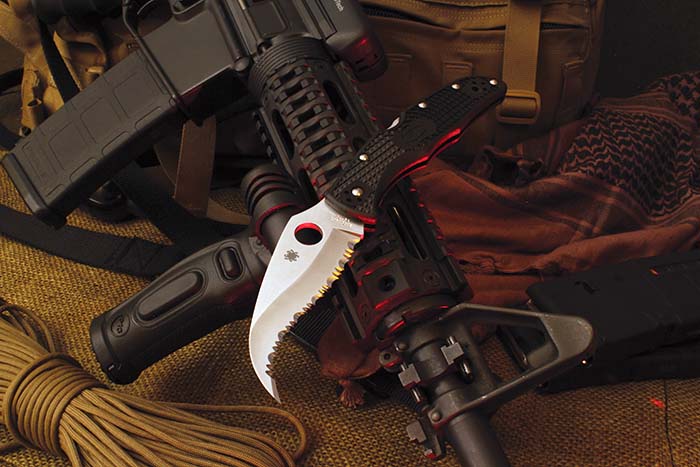By Oleg Volk –
The esoteric Lewis Machine and Tool Confined Space Weapon 300 (LMT CSW300) is the logical evolution of the many attempts to downsize the M16 rifle for special operations needs. Super compact variants like the Colt Commando date back to the late 1960s, but those had to be padded out to longer overall length with blast-reducing flash hiders to assist in cycling. The end result was a lightweight but marginally effective short barreled 5.56mm rifle used by some Special Forces and, as a survival carbine, by military pilots.
Maximizing Close-Range Effectiveness
The main problem of the Commando was that its ammunition was optimized for much longer rifle barrels. From 10.5-inch tubes, it simply lacked the velocity to make a 55gr bullet sufficiently effective past 100 yards. 7.62x35mm, also known as .300 Blackout, was developed from the start as a cartridge for short barrels, with many loads optimized for sound suppressed use. Whereas 5.56mm tops out at 77 grains, .300 BLK provides 220 grain options at the same velocity. The cartridge works with all the same components, other than the barrel. Compared to the other traditional CQB choice, 9x19mm in HK’s MP5 SD and similar submachine guns, .300 BLK gives both better subsonic performance and the option to run significantly faster supersonic bullets in the 110- to 150-grain range. Built from the ground up as a .300 BLK rifle, LMT CSW300 aimed to make the best of the recent ammunition and sound moderation developments.
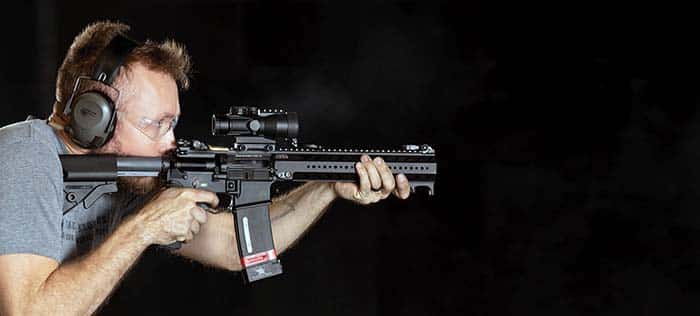
LMT CSW300 Features
The core of the weapon is a 1:7 twist, 8.15-inch, chrome-lined barrel with a matched sound suppressor permanently attached for the total length of 11.8 inches. Thanks to that compact configuration, and the specialized reduced length 6-position stock and buffer, LMT CSW300 is only 24.3 inches long with the stock collapsed, 27.6 inches extended. Because it features both a sound suppressor and a barrel shorter than 16 inches even with the suppressor attached, it requires two $200 NFA tax stamps for individuals to own. The barrel and suppressor unit are removable for maintenance. The carbine is hefty for its size, with most of the 7.3-pound weight accruing to the sound suppressor, the barrel and the full-length enveloping forend. The idea behind this configuration was to maximize close-range effectiveness for entry teams, armored vehicle crews and bodyguards.
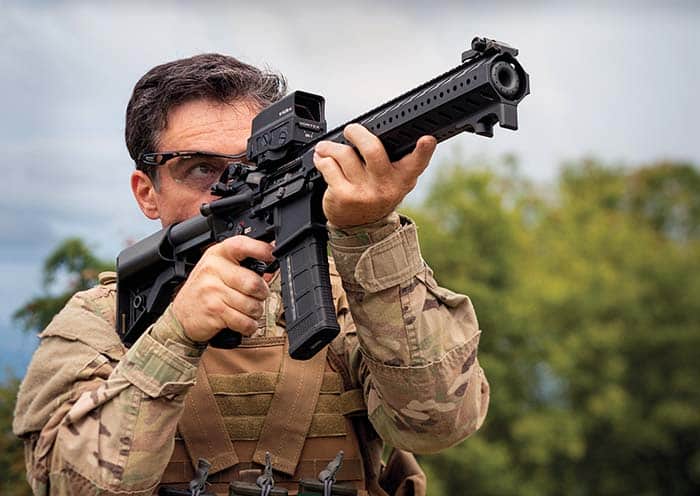
The LMT CSW300 lower receiver is enhanced with a secondary left-side magazine release. It comes with a very good, crisp two-stage trigger that permits good control even with gloves on. To institutional users, the LMT CSW300 is available in select-fire form with cyclic rates in the 700 to 900 rounds per minute range, depending on the ammunition used. The wide forend protects the sound suppressor from impacts and provides a good standoff from the barrel. At the front of the forend, two downward projections provide indexing for the support hand for maximum direction control without fingers straying before the muzzle. Applying pressure to the very end of the weapon allows precise control both in the aiming and in the recoil control stages of the shot. While the standoff between the suppressor and the forend is smaller there, the can warms up relatively slowly. With gloves on, extended continuous fire is possible before significant discomfort.
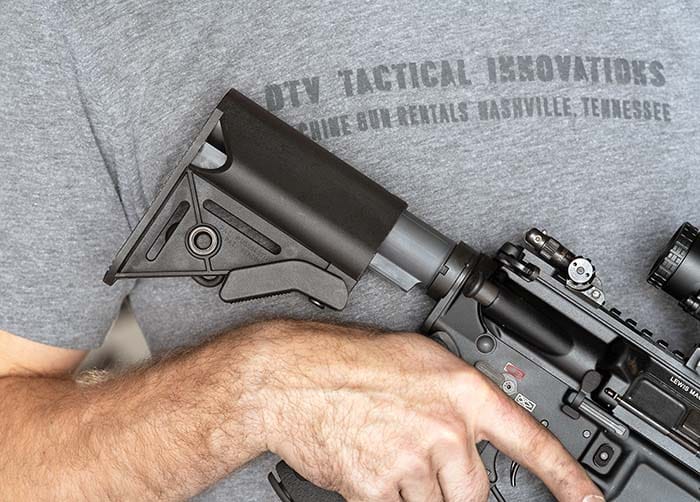
The upper receiver features an 18-inch monolithic rail equipped with high quality adjustable folding iron sights and is equally suitable for optics and night vision equipment. The carbine comes with four short rail segments for attaching to threaded holes on the sides of the forend as needed for lights, lasers and other accessories. An ambidextrous charging handle completes the composition.
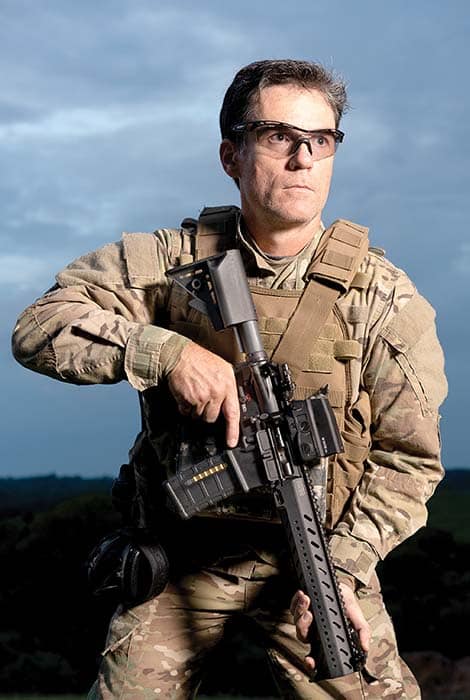
Test Results
I tested the carbine with the supplied Vortex Razor AMG UH1 holographic sight and with a Primary Arms Gen II 5x Compact Prism scope. With the UH1, the weapon is extremely fast and plenty accurate—this is the real-world use configuration suitable for hitting sporting clays on the 65-yard berm off hand. The magnified optic was used for more deliberate accuracy testing from a support. The three subsonic loads, SIG SAUER and Black Hills 220gr, and Gemtech 187gr, all turned in very respectable 1.5MOA groups. Testing was done at the same 65 yards, with 1-inch spreads for all three. Remington 220gr match grouped less well at 2.5MOA. Aguila 150gr FMJ grouped at 2.25MOA—quite good for a barrel optimized for heavier bullets.
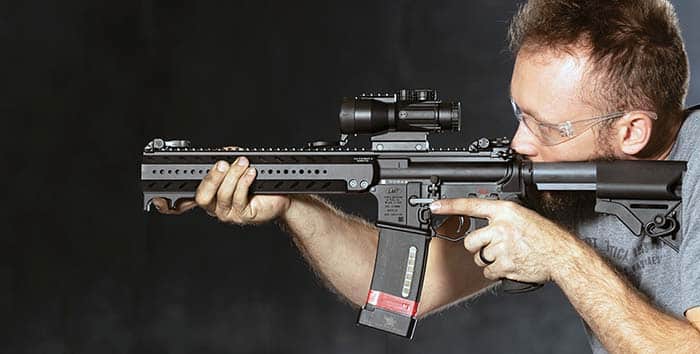
LMT CSW300 has no visible muzzle signature at all, neither flash nor any significant smoke. The rifle also eliminates most of the blowback towards the shooter effectively. The very short direct impingement gas system results in most of the gas and some of the burning powder manifesting at the ejection port. About 40% of the shots made with Remington subsonics and about 15% of the shots taken with SIG SAUER ammunition produced bright, warm fireballs at the ejection port (see photo). That makes the carbine with those rounds uncomfortable by left-handers, ambidextrous controls notwithstanding. While watching videos of other samples of LMT CSW300 in use, I did not see the ejection port flames, but it can be a known issue with short gas systems.
The Good, the Bad and the Dirty
On the plus side, these two loads functioned 100%. I had to go to the LMT engineers about the next issue. Gemtech ammunition did not produce fireballs but short-cycled consistently, ejecting empties without loading the next cartridge into the chamber. Black Hills ammunition, while very accurate, required completely manual cycling, mostly not even unlocking the bolt. This is consistent with chronographed velocities, around 850fps for the SIG and the Remington loads and under 900fps for Black Hills and Gemtech. My best guess was that faster powders used by SIG SAUER and Remington produce both the higher velocity and more of a fireball at the ejection port. The effect appeared at once on a brand new carbine, so it couldn’t have been unburned powder residue. An LMT engineer explained that the wide range of pressure curves between various .300 BLK loads requires tuning the rifle to them—in this case, by taking the anti-bounce weight out of the bolt carrier to enable cycling with the lower port pressure ammunition. Aguila supersonics mostly worked, but by then I ran into another side effect of suppressing such a short weapon: it can run dirty. All the carbon has to go somewhere, so 150 rounds of assorted subsonics were enough to gunk up the gun. Chambering the first round eventually required the use of forward assist, and I had four more failures to go into battery out of 20 rounds. LMT recommends the Hornady and Black Hills ammunition and cleaning every 200 rounds. I did not try just using 200 rounds of Hornady or Black Hills to see if I had the same issue as when all the different rounds were used.

Optimal Defense Weapon
All designs are optimized for certain features, and LMT CSW300 is no exception. Its suppressor does a great job of eliminating gas blowback and stays cool enough for firing about 100 shots in an engagement. The sound reduction is noticeable, but the report—possibly aggravated by the ejection port pop—remains unpleasant to the ear without being immediately damaging. The system is rated 138–139dB with subsonic ammunition. Given the high muzzle pressure inherent in short barrel rifles, this may be physically the best result possible. Ear plugs are recommended even outdoors with subsonic ammunition. In serious use, active hearing protection is worn anyway to attenuate the noise of the opposition’s gunfire. In sum, LMT CSW300 works as an entry or sudden self-defense weapon, provided it is cleaned regularly and compatible ammunition is used.
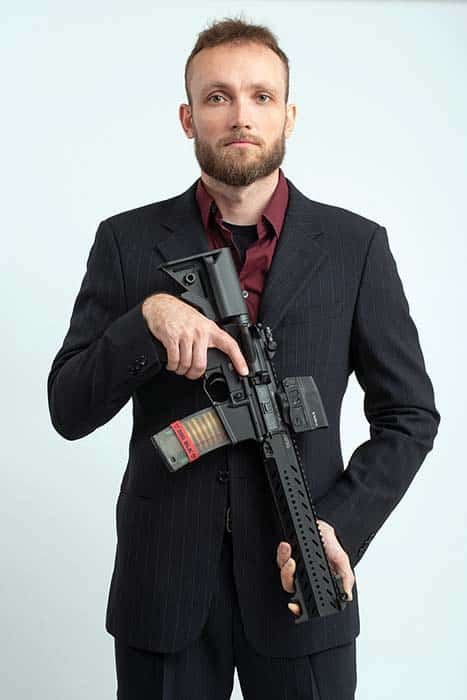
| This article first appeared in Small Arms Review V23N3 (March 2019) |




